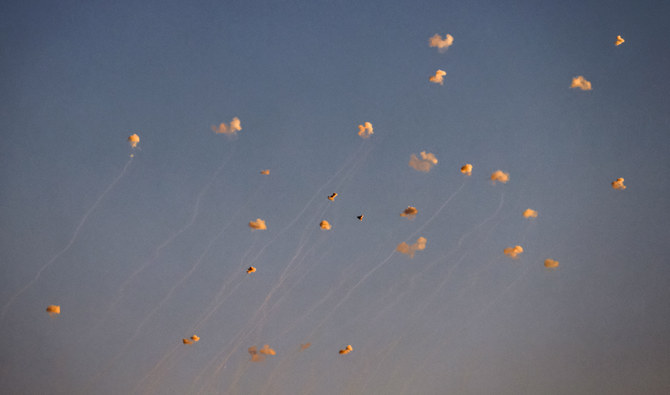BEIRUT: Hezbollah said it fired “dozens” of rockets Thursday at a military base in northern Israel in retaliation for Israeli strikes on Lebanon, announcing four of its fighters had been killed.
Fears of all-out war between Israel and Hezbollah have risen in recent weeks as threats have intensified between the sides, which have traded regular cross-border fire since Hamas’s October 7 attack on Israel sparked war in the Gaza Strip.
Hamas ally Hezbollah said that “in response to the enemy attacks that targeted the city of Nabatiyeh and village of Sohmor,” its fighters bombed “the main air and missile defense base of the (Israeli) northern area command... with dozens of Katyusha rockets.”
It said in separate statements that four of its fighters, one from eastern Lebanon’s Sohmor, had been killed, and claimed two other attacks on Israeli troops and positions, including one with drones.
The Israeli military said in a statement that “approximately 35 launches were identified crossing from Lebanon.”
Air defenses “successfully intercepted most of the launches. No injuries were reported,” it added.
It said air strikes “eliminated” three Hezbollah operatives, one in the Sohmor area and two in the country’s south.
The military also said that “two UAVs (drones) that were identified crossing from Lebanon fell” in northern Israel, reporting no injuries.
Lebanon’s official National News Agency reported Israeli attacks in several areas of south Lebanon on Thursday, and said a strike a day earlier in Nabatiyeh wounded “more than 20” people when a two-story building was targeted.
Fears have grown the Gaza war could become a regional conflagration if the Israel-Hezbollah conflict, which so far has been largely limited to the border area, expands.
France’s foreign ministry said Thursday that Paris was “extremely concerned” about the fighting, calling “all sides to exercise the greatest restraint.”
Israeli Defense Minister Yoav Gallant said during a visit to Washington on Wednesday that his country did not want war in Lebanon, but could send it back to the “Stone Age” if diplomacy failed.
Amid Western diplomatic efforts to dial down tensions in recent months, German Foreign Minister Annalena Baerbock on Tuesday visited Beirut and cautioned that “miscalculation” could trigger all-out war, also urging “extreme restraint.”
The violence has killed 485 people in Lebanon, most of them fighters but also including 94 civilians, according to an AFP tally.
On the Israeli side, at least 15 soldiers and 11 civilians have been killed, according to authorities.























